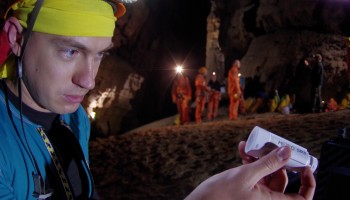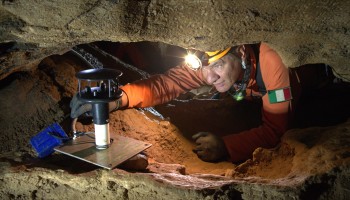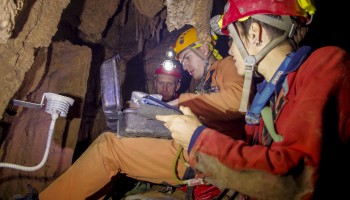Meteorology in caves
Caves are rather stable climatic environments, with an almost constant temperature and high degrees of relative humidity. Nonetheless, detailed measurements of climatic parameters allow the finding of small variations that cause underground “weather” changes.
Several meteorological parameters, including temperature, water vapour, pressure, wind speed and direction is measured in the cave’s air. Astronauts are asked to download data, save data files, and make preliminary observations.
Operational scenario
Air temperature and relative humidity are measured at 30 minute intervals by HOBO dataloggers. These are launched on the morning of Day 1 and placed in three monitoring stations: one in the low (lake) level of the cave, one half-way up, and the third close to the ceiling. Data downloading takes place on Day 6, during the transit from Base Camp to the exit.
Atmospheric pressure is measured by a HOBO datalogger located at the fourth Wind station. It measures pressure every 30 minutes. Data are downloaded twice, once upon arrival at fourth Wind station on Day 1 and a second time on Day 6 before leaving the cave.
In parallel with pressure (Day 1 and Day 6), wind speed and direction are downloaded at the fourth Wind Station. This monitoring device was installed in 2011 and registers data on air currents at 30-minute intervals.

Small variations in climatic parameters can cause underground “weather” to change. Credits: ESA-V.Crobu
All data are stored on the netbook used to download data from monitoring devices.
Things to keep in mind
HOBO sensors.
These sensors are rugged and waterproof, but it is better to handle them with care. Once powered, it is necessary to check whether they are working (small red flashing light). Before downloading, since the reading is optical, the plastic screen of the sensor must be cleaned with a cleaning wipe (stored with the cables).
Pressure datalogger
The jack port must be unscrewed with a screwdriver (stored with the cables). When closing this port, don’t screw the lid too tightly but make sure that the watertight ring is correctly placed.
Wind station
This station is not really designed for the hostile (extremely wet) cave environment. The waterproof case is rugged and good, but the cables are not. When removing and plugging in the wind sensor cable (right) handle it with care. Delicate hands are really recommended here!
Checking that the wind station is working properly after data download (see procedures) can take more than a minute. Be patient.
4th Wind
The wind station location is a really nasty site, and downloading data can take more than half an hour. Install yourself comfortably, sitting on your rucksack (that isolates from the cold floor).
Prof. Jo De Waele, University of Bologna, CAVES science coordinator.
Dr. Laura Sanna, Institute for Biometeorology, Sassari, scientist responsible for the CAVES meteorology experiments.



Discussion: no comments